
Harpers Ferry is a historic town in Jefferson County, West Virginia, United States, in the lower Shenandoah Valley. The population was 285 at the 2020 census. Situated at the confluence of the Potomac and Shenandoah rivers, where the U.S. states of Maryland, Virginia, and West Virginia meet, it is the easternmost town in West Virginia.

Storer College was a historically black college in Harpers Ferry, West Virginia, that operated from 1867 to 1955. A national icon for black Americans, in the town where the 'end of American slavery began', as Frederick Douglass famously put it, it was a unique institution whose focus changed several times. There is no one category of college into which it fits neatly. Sometimes white students studied alongside black students, which at the time was prohibited by law at state-supported schools in West Virginia and the other Southern states, and sometimes in the North.

John Daniel Imboden, American lawyer, Virginia state legislator, and a Confederate army general. During the American Civil War, he commanded an irregular cavalry force. After the war, he resumed practicing law, became a writer, and was active in land development founding the town of Damascus, Virginia.
The Battle of Cool Spring, also known as Castleman's Ferry, Island Ford, Parker's Ford, and Snicker's Ferry, was a battle in the American Civil War fought July 17–18, 1864, in Clarke County, Virginia, as part of the Valley Campaigns of 1864. The battle was a Confederate victory.
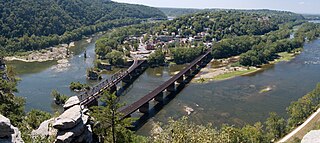
Harpers Ferry National Historical Park, originally Harpers Ferry National Monument, is located at the confluence of the Potomac and Shenandoah rivers in and around Harpers Ferry, West Virginia. The park includes the historic center of Harpers Ferry, notable as a key 19th-century industrial area and as the scene of John Brown's failed abolitionist uprising. It contains the most visited historic site in the state of West Virginia, John Brown's Fort.

John Brown's Fort was initially built in 1848 for use as a guard and fire engine house by the federal Harpers Ferry Armory, in Harpers Ferry, Virginia. An 1848 military report described the building as "An engine and guard-house 35 1/2 x 24 feet, one story brick, covered with slate, and having copper gutters and down spouts…"

Virginius Island is a formerly inhabited island of some 12 acres (4.9 ha), on the Shenandoah River in Harpers Ferry, West Virginia. The island was created by the Shenandoah Canal, constructed by the Patowmack Company between 1806 and 1807, which separates it from the town of Harpers Ferry. The canal was constructed to enable boats to bypass rapids on the river, and also channel water to drive machinery. In the nineteenth century Virginius Island contained Harpers Ferry's industry and working-class housing: a boarding house and row houses. Virginius Island is part of the Harpers Ferry National Historical Park.
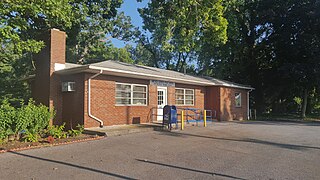
Rippon is an unincorporated community in Jefferson County, West Virginia, United States, located south of Charles Town and designated as a village by the Jefferson County Commission. The village of Rippon developed in the mid-19th century at the crossroads of the Berryville and Charles Town Turnpike, Withers-LaRue Road, and Myerstown Road. The town was named after nearby Ripon Lodge, although an extra "p" was added to avoid confusion with a town in Wisconsin. According to the 2000 census, the town has a population of 223.
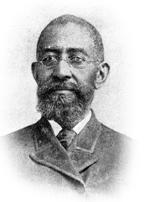
John William Dunjee was an American missionary, educator, Baptist minister, publisher, agent of Storer College and founder of Baptist churches across the United States.

Talladega College is a private historically black college in Talladega, Alabama. It is Alabama's oldest private historically black college and offers 17 degree programs. It is accredited by the Southern Association of Colleges and Schools.

The city of Winchester, Virginia, and the surrounding area, were the site of numerous battles during the American Civil War, as contending armies strove to control the lower Shenandoah Valley. Winchester changed hands more often than any other Confederate city.
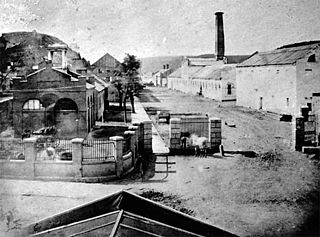
The Harpers Ferry Armory, more formally known as the United States Armory and Arsenal at Harpers Ferry, was the second federal armory created by the United States government; the first was the Springfield Armory. It was located in Harpers Ferry, Virginia, which since 1863 has been part of West Virginia. It was both an arsenal, manufacturing firearms, and an armory, a storehouse for firearms. Along with the Springfield Armory, it was instrumental in the development of machining techniques to make interchangeable parts of precisely the same dimensions.
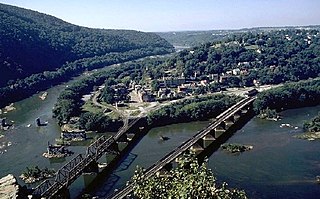
The B & O Railroad Potomac River Crossing is a 15-acre (6.1 ha) historic site where a set of railroad bridges, originally built by the Baltimore and Ohio Railroad, span the Potomac River between Sandy Hook, Maryland and Harpers Ferry, West Virginia. The site was added to the National Register of Historic Places on February 14, 1978, for its significance in commerce, engineering, industry, invention, and transportation.

The Harpers Ferry Historic District comprises about one hundred historic structures in Harpers Ferry, West Virginia. The historic district includes the portions of the central town not included in Harpers Ferry National Historical Park, including large numbers of early 19th-century houses built by the United States Government for the workers at the Harpers Ferry Armory. Significant buildings and sites include the site of the Armory, the U.S Armory Potomac Canal, the Harpers Ferry Train Station, and Shenandoah Street, Potomac Street, and High or Washington Street. The National Historic Park essentially comprises the lower, flood-prone areas of the town, while the Historic District comprises the upper town.

John E.P. Daingerfield was Acting Paymaster at the Harpers Ferry Armory at the time of John Brown's 1859 Raid; he was taken hostage but not injured.
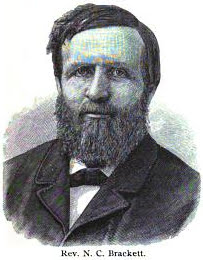
Nathan Cook Brackett (1836–1910) was an abolitionist, Free Will Baptist pastor, first president of Storer College, and chairman and co-founder of Bluefield State College.

John Storer was a merchant and philanthropist from Sanford, Maine, who was the namesake of Storer College in Harpers Ferry, West Virginia.

Celeste Brackett Newcomer was an American educator, bank director, and clubwoman based in Harpers Ferry, West Virginia.


















